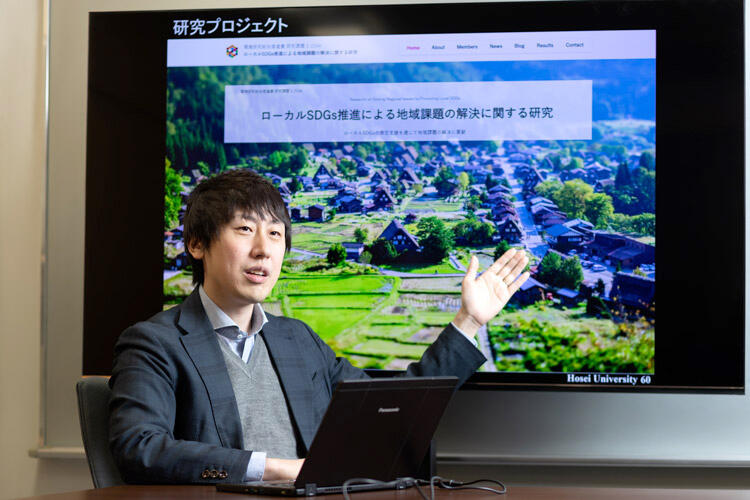
The Local SDGs movement, which introduces approaches to the Sustainable Development Goals (SDGs) and focuses on solving regional issues and on revitalization, is attracting attention across Japan. For regional communities that are setting out across the uncharted seas of a sustainable future, the SDGs' role is that of a compass, showing the route they can take to arrive at an ideal future. We spoke to Professor Shun Kawakubo of the Faculty of Engineering and Design, Hosei University, who is gathering realistic local data and constructing a platform to share information, the most important resource for the implementation of the SDGs, with many people.
Working toward a deeper understanding and effective application, rather than a buzzword
The planet currently faces a huge number of issues. In 2015, the UN set out the SDGs with the aim of solving these issues. Many people have been made aware of the SDGs, and initiatives working toward these 17 goals are going ahead around the world. Local SDGs, which adapts these ideas for regional development, is incorporated into the comprehensive plans of many local governments and is also being supported by the national government.
Professor Kawakubo is the research director of Research on Solving Regional Issues by Promoting Local SDGs, a project of the Ministry of the Environment's Environment Research and Technology Development Fund. He is pouring his efforts into raising awareness, as well as into his busy research, so that the SDGs don't just end as a mere buzzword.
The SDGs are not something from another world. For regional communities, it is important that they take on the characteristics of the three roles of a "compass" that shows the direction of initiatives from a long-term perspective, a "common language" that encourages cooperation with related parties, and an "engine" that continuously drives initiatives. Professor Kawakubo's current aim is the promotion of effective application and understanding from the standpoint of utilization.
Visualizing "effort" and transcending space and time
Likening the SDGs to a compass means using the SDGs as a standard, similar to the magnetic North and South Poles used for a topographical compass, and thus enabling people to see the current position of initiatives that look to the future in regional communities and the direction they should take from now on.
Using the different perspectives of the 17 goals to pick out actual initiatives taking place in regional areas and connecting them enables people to gain an understanding of the overall picture as a story with a bird's-eye view, and makes it possible to share this with large numbers of people. Doing this makes the activities to which a region is committed - i.e. their "efforts" - visible, and will assist not just that region at this moment in time, but also transcend time and space to be of use to other regions and later generations. This is where the value of Local SDGs lies.
The important points are constructing a story and sharing information with a wide range of people. The issues that regional areas face are made up of a combination of things particular to that region and things that are common across different regions, so knowledge of both is needed to solve them. Moreover, making it possible to share examples and data from different regions will enable people to learn about past cases in other regions, and create a catalyst for public-private collaboration that understands local needs.
Thus, this article introduces the story of Shimokawa Town, Hokkaido, as a representative example of regional success, and the Local SDGs Platform as knowledge that can be widely used.
The story of Shimokawa Town, developing with the forest
Professor Kawakubo has a personal theory: "The answer lies in the local area." In order to understand the true situation in regional areas, he has visited places around the country and listened to the people there. "Excellent initiatives are being carried out across the country, but the people who lead them also face a variety of struggles, which offer rich experience value. I think that, to share these, the most important thing is to actually meet people and listen to what they have to say."
During this fieldwork, he came across the efforts of Shimokawa Town, which is located in the north of Hokkaido.
"This is a forest town, so of the 17 SDGs, the initial decision was to focus on Goal 15, Life on Land. On top of this, beyond the cycle of planting, growing and felling trees lies Goal 12, Responsible Consumption and Production. Shimokawa Town started initiatives working toward the SDGs with a focus on these two goals," Professor Kawakubo began explaining.
"When they did so, there was a ripple effect. For example, the townspeople and tourist forest therapy experience contributes to Goal 3, Good Health and Well-Being, and forest environmental education and mokuiku (growing with trees) aimed at students on excursions, etc., contribute to Goal 4, Quality Education. In addition, the jobs created by stimulating the forestry industry contribute to Goal 8, Decent Work and Economic Growth, and the use of wooden biomass resources to Goal 7, Affordable and Clean Energy, and Goal 13, Climate Action," he continued.
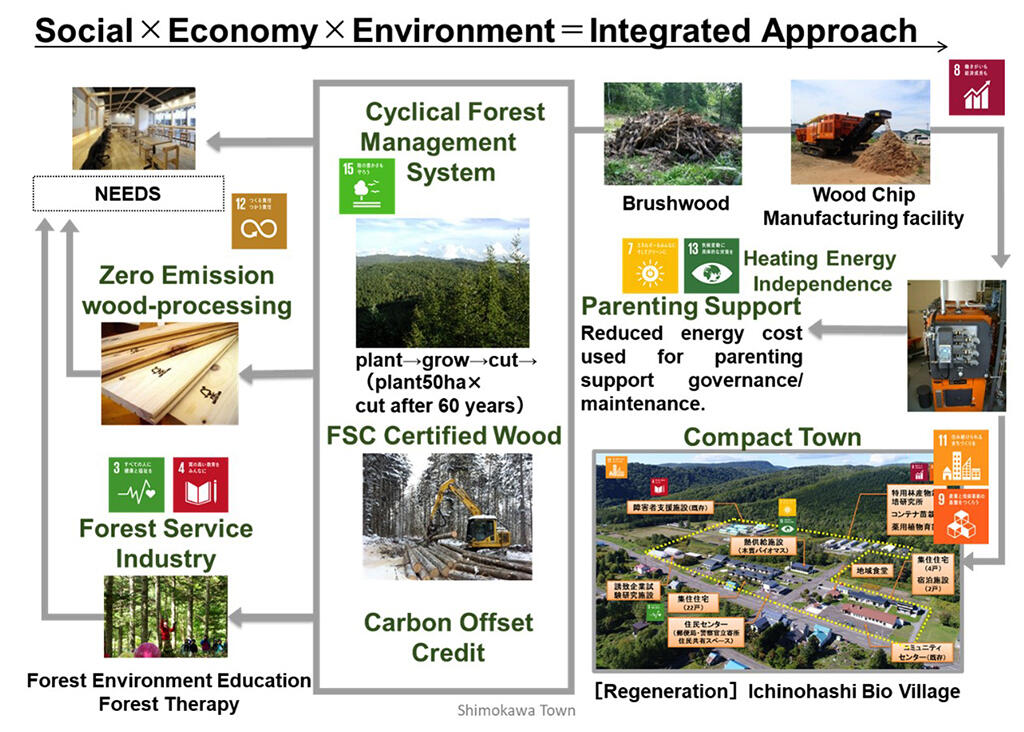
(Source: a presentation by the mayor of Shimokawa)
"In this way, the town created a story using the common language of the SDGs, and through this the sympathy of related parties grew, encouraging collaboration and co-creation. Localities and companies that wanted to collaborate also appeared. The SDGs are an extremely effective communication and branding tool," he said.
Professor Kawakubo also uses this example when he's explaining Local SDGs in different areas. "When I talk about it, everyone is surprised. 'So that's what the SDGs are,' they say." "If it's okay to start by focusing on what we can do among the 17 goals...," small local governments and companies say in response, and their efforts are increasing.
Tremendously effective as a tool
His research team started by developing the Local SDGs Platform, and this began operating in 2018. Data from local governments across the country is stored here, and users can search for any local government and view different types of data and scores compared with the national average. "It's like a health checkup for local governments," Professor Kawakubo explained. It is also possible to reference the initiatives of local governments that have performed well in entries similar to issues in the user's region, and to propose collaborations. The team is analyzing users' access data to further their research.
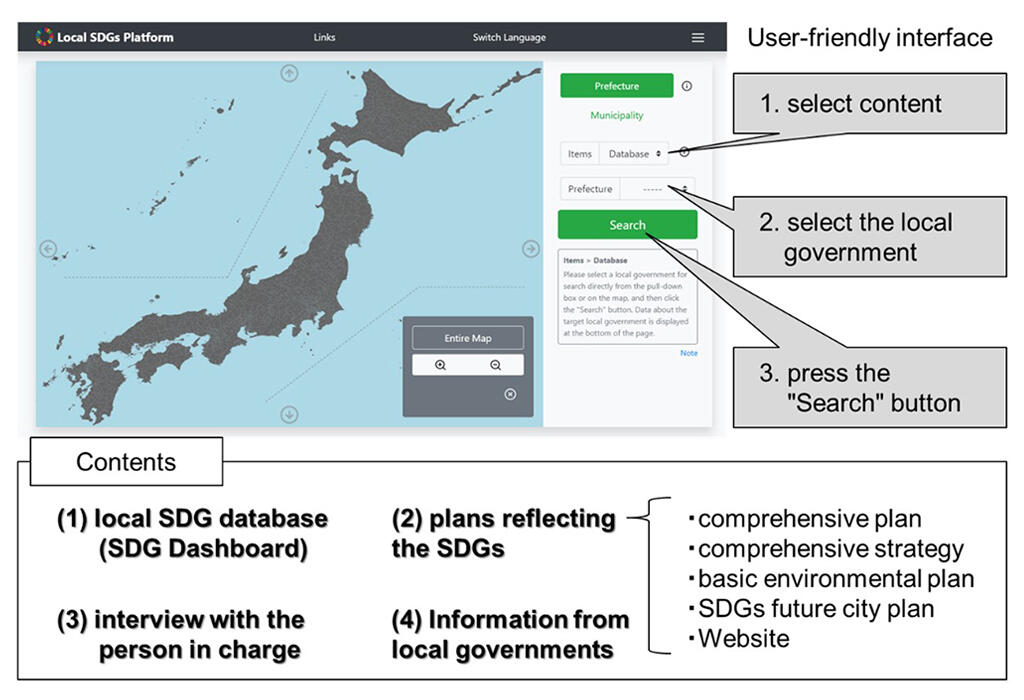
(provided by Professor Kawakubo and modified by JST)
Based on the requests received as they operate the Local SDGs Platform, the team created a new online SDGs platform, Platform Clover, which lets private companies and members of the public share their own efforts. This makes it easier to find collaborative partners based on information concerning activity aims, activity content, needs (support required) and seeds (value that can be provided).
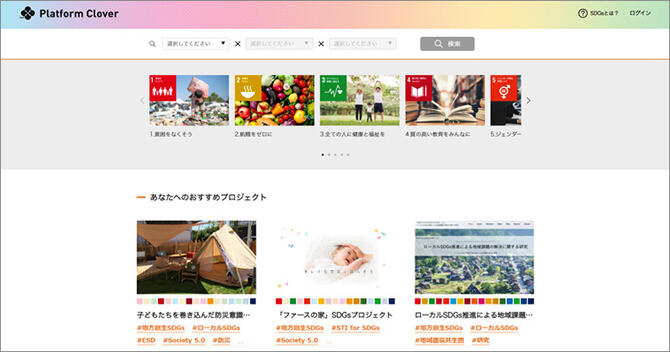
(provided by Professor Kawakubo)
The SDG Indicator DB, which the team developed next, stores indicators that show progress towards the achievement of goals, and allows users to learn about the initiatives of local governments and companies around the country. Professor Kawakubo commented, "We want this to serve as a catalyst for public-private collaboration, with companies exploring the needs of local governments, and local governments searching for companies that may help to solve their problems."
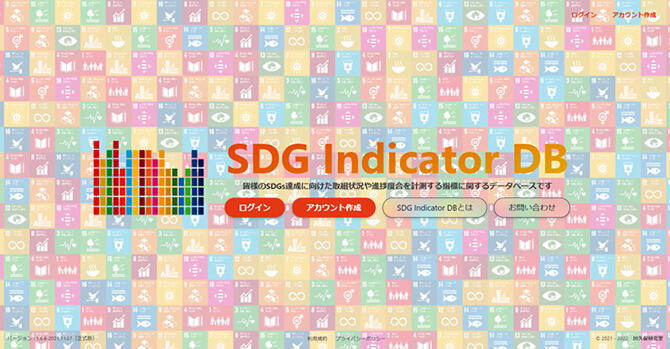
(provided by Professor Kawakubo)
Now the team is developing an SDGs automatic mapping AI together with Osaka University and the University of Hyogo, with the aim of installing this on Platform Clover. Users enter details of their initiative into the input form, e.g. a medium-term management plan, and the AI will determine which parts of the text are relevant to which goal, and inform the user. Conversely, if users enter issues or needs, the AI will calculate their relevance ratio to the 17 goals, match this to the registered seeds of private companies, and propose partner candidates.
"The SDGs are tremendously effective when used as a tool," Professor Kawakubo emphasized.
2030 is a checkpoint, with further focus on the future
There is something that Professor Kawakubo always makes sure to convey when he visits different areas: "The SDGs are a checkpoint." The SDGs "end" in 2030, but regional development won't stop then.
People mustn't stop making efforts to construct a sustainable society once 2030 arrives. Regional efforts and change can't be judged in less than 10 or 20 years, and it will be after 2030 that the outcomes of today's initiatives become visible. If people stop trying before their efforts bear fruit, then society in the second half of the 21st century will backslide to the state it was in the past. The SDGs aren't goals that finish in 2030, and initiatives that look to the future will be important to regional society beyond that point.
In the second half of the 2020s, people will likely start establishing new goals to serve as a global compass after 2030. Initiatives that focus on this are important to the creation of a better future. "Japan has faced a variety of problems before now, including environmental issues and the aging population/falling birthrate. As we are a frontrunner with these issues, surely we have a major role to play in the creation of a global framework. The SDGs themselves aren't perfect, and their content will need to change in the future. I hope to create a Vision 2030 Agenda and Post-SDGs world with you all (especially young people)," said Professor Kawakubo, enthusiastically.
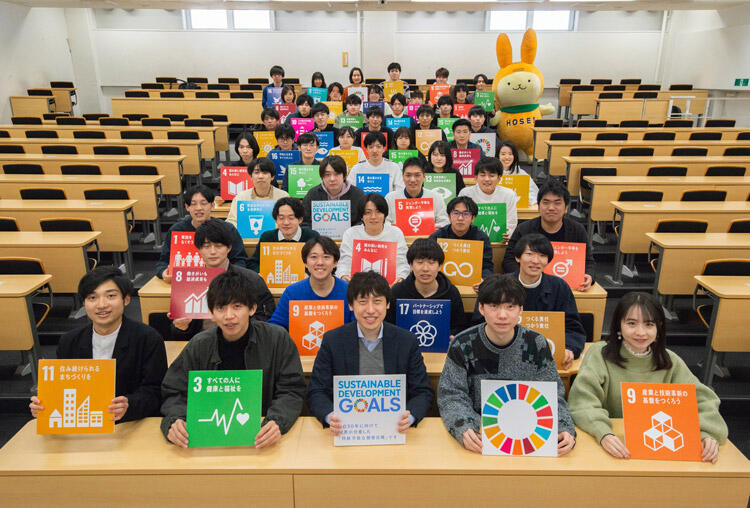
(provided by Professor Kawakubo)
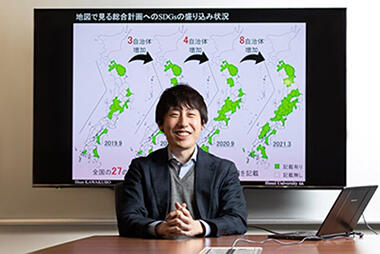
KAWAKUBO Shun
Professor, Department of Architecture, Faculty of Engineering and Design, Hosei University.
Graduated from the Ph.D. program of the Faculty of Science and Technology, Keio University.
He took up his current position in 2021, after serving as an Assistant Professor, full time instructor and Associate Professor in the Department of Architecture, Faculty of Engineering and Design, Hosei University.
He has been interested in sustainable development since his student days, and aims to solve issues facing different regions from his position as a researcher.
Original article was provided by the Science Portal and has been translated by Science Japan.




